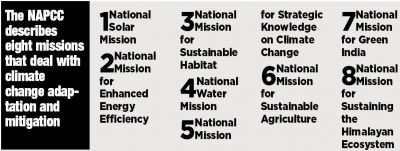National Mission on Sustaining Himalayan Ecosystem | 14 Apr 2021
Why in News
Scientists, with support from the National Mission on Sustaining Himalayan Ecosystem (NMSHE) Programme, have been able to disseminate available scientific information to the farmers to enable sustainable and climate-resilient agriculture in the Leh region.
- NMSHE is one of the eight missions under the National Action Plan on Climate Change (NAPCC).
Key Points
- About:
- It was launched in 2010 but was formally approved by the government in 2014.
- It is a multi-pronged, cross-cutting mission across various sectors.
- It contributes to the sustainable development of the country by enhancing the understanding of climate change, its likely impacts and adaptation actions required for the Himalayas- a region on which a significant proportion of India’s population depends for sustenance.
- States Covered:
- Eleven states: Himachal Pradesh, Uttarakhand, Sikkim, Arunachal Pradesh, Nagaland, Manipur, Mizoram, Tripura, Meghalaya, Assam and West Bengal.
- Two Union Territories: Jammu and Kashmir and Ladakh.
- Objective:
- To facilitate formulation of appropriate policy measures and time-bound action programmes to sustain ecological resilience and ensure the continued provisions of key ecosystem services in the Himalayas.
- To evolve suitable management and policy measures for sustaining and safeguarding the Himalayan ecosystem along with developing capacities at the national level to continuously assess its health status.
- To address a variety of important issues, including studying the Himalayan glaciers and associated hydrological consequences and prediction and management of natural hazards.
- Himalayas:
- About:
- The Himalayas are the highest and the youngest fold mountain ranges of the world.
- Their geological structure is young, weak and flexible since the Himalayan uplift is an ongoing process, making them one of the highest earthquake-prone regions of the world.
- It separates India, along its north-central and northeastern frontier, from China (Tibet).
- Area:
- The Indian part of Himalayas covers an area about 5 lakh km2 (about 16.2% of the country's total geographical area) and forms the northern boundary of the country.
- The region is responsible for providing water to a large part of the Indian subcontinent. Many rivers considered holy like the Ganga and Yamuna flow from the Himalayas.
- Ranges:
- The Himalayas are a series of parallel mountain ranges extending along the North-West to the South-East direction (known as the Strike of the Himalayas). These ranges are separated by longitudinal valleys. They include,
- Trans-Himalayas
- The Greater Himalayas or Himadri
- The Lesser Himalayas or Himachal
- Shiwaliks or the Outer Himalayas
- The Eastern Hills or Purvanchal
- The Himalayas are a series of parallel mountain ranges extending along the North-West to the South-East direction (known as the Strike of the Himalayas). These ranges are separated by longitudinal valleys. They include,
- About:
National Action Plan on Climate Change
- About:
- It was launched in 2008 by the Prime Minister's Council on Climate Change.
- The Ministry of Environment, Forest and Climate Change (MoEFCC) is the coordinating Ministry of NAPCC.
- Aim:
- Creating awareness among the representatives of the public, different agencies of the government, scientists, industry and the communities on the threat posed by climate change and the steps to counter it.
- Missions:
- There are 8 national missions forming the core of the NAPCC which represent multi-pronged, long term and integrated strategies for achieving key goals in climate change.

- National Solar Mission: This initiative started in 2010 to promote the use of solar power.
- National Mission for Enhanced Energy Efficiency: The initiative was undertaken in 2009 to promote the market for energy efficiency by fostering innovative policies and effective market instruments.
- National Mission on Sustainable Habitat: Approved in 2011, it aims to make cities sustainable through improvements in energy efficiency in buildings, management of solid waste and shift to public transport.
- National Water Mission: The mission was put in place to ensure integrated water resource management helping to conserve water, minimize wastage and ensure more equitable distribution both across and within states.
- National Mission for Sustaining the Himalayan Ecosystem: It is aimed at protecting the Himalayas, it has mapped institutes and civil society organisations working on the Himalayan ecology for ease of coordination between governmental and non-governmental agencies.
- National Mission for A Green India: It aims at protecting; restoring and enhancing India's diminishing forest cover and responding to climate change by a combination of adaptation and mitigation measures. It was started in 2014.
- National Mission for Sustainable Agriculture: It has been formulated for enhancing agricultural productivity especially in rain-fed areas focusing on integrated farming, water use efficiency, soil health management and synergizing resource conservation. It was started in 2010.
- National Mission on Strategic Knowledge for Climate Change: It seeks to build a dynamic and vibrant knowledge system that informs and supports national policy and action for responding effectively to climate change challenges, while not compromising on the nation's growth goals.
- There are 8 national missions forming the core of the NAPCC which represent multi-pronged, long term and integrated strategies for achieving key goals in climate change.
